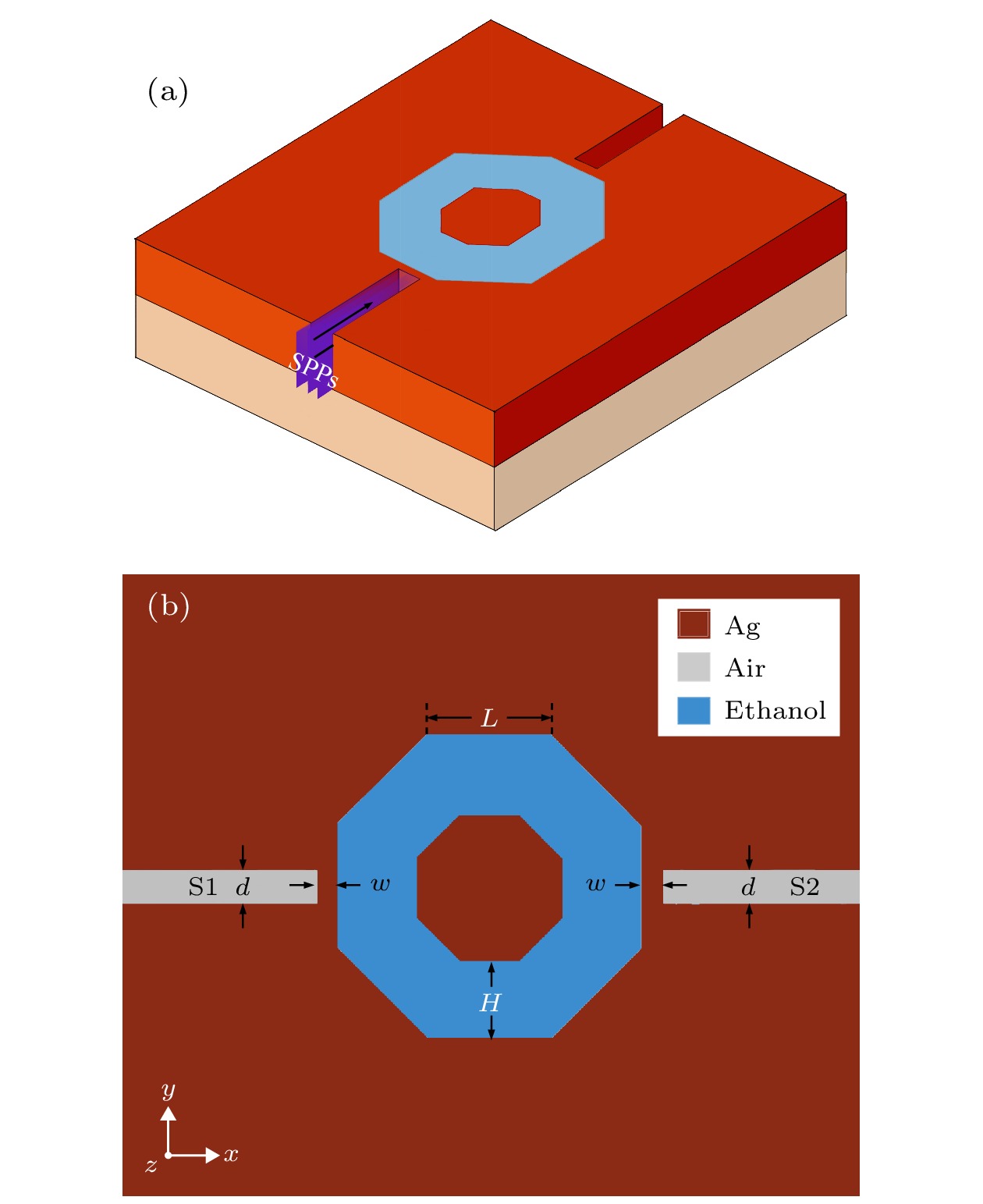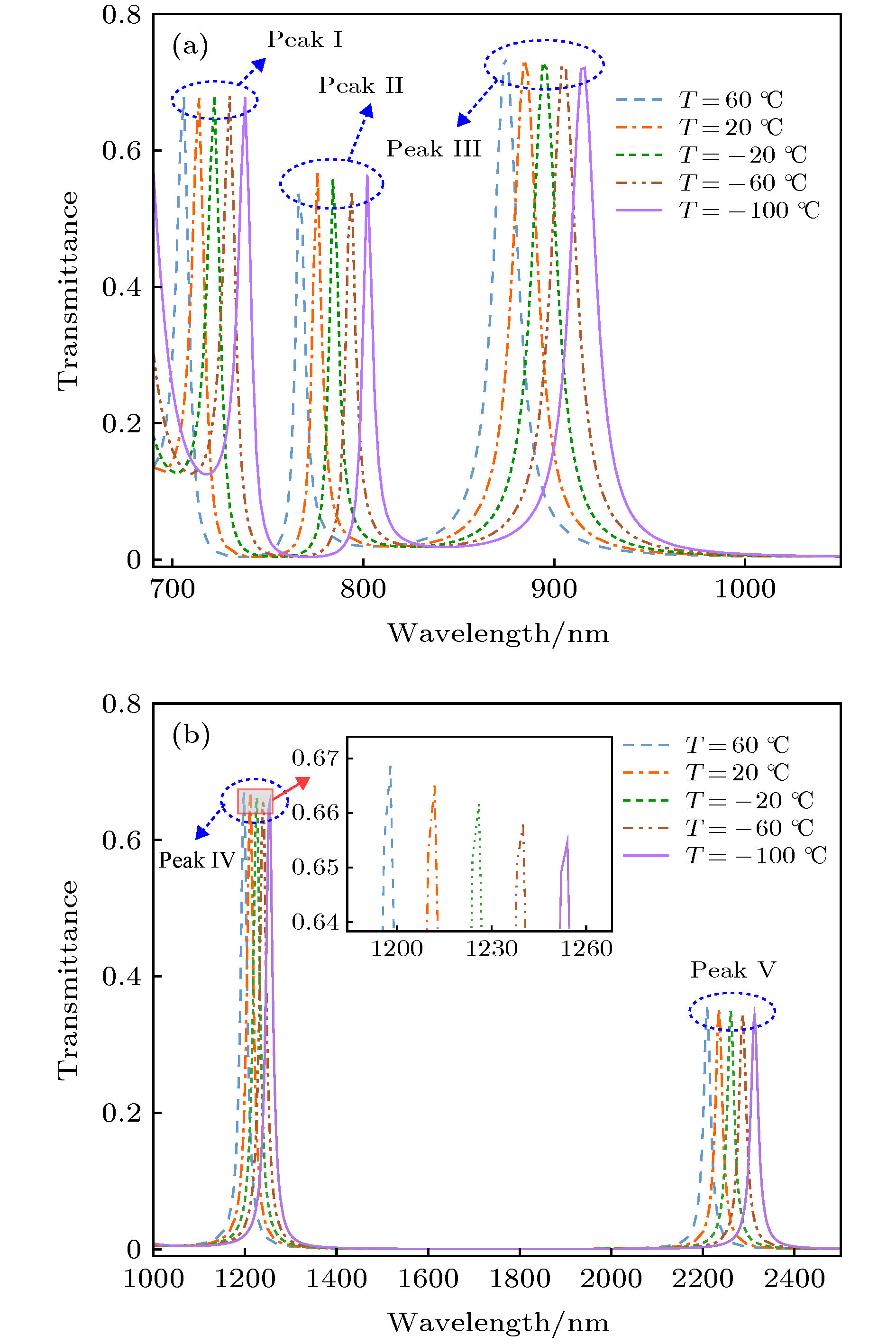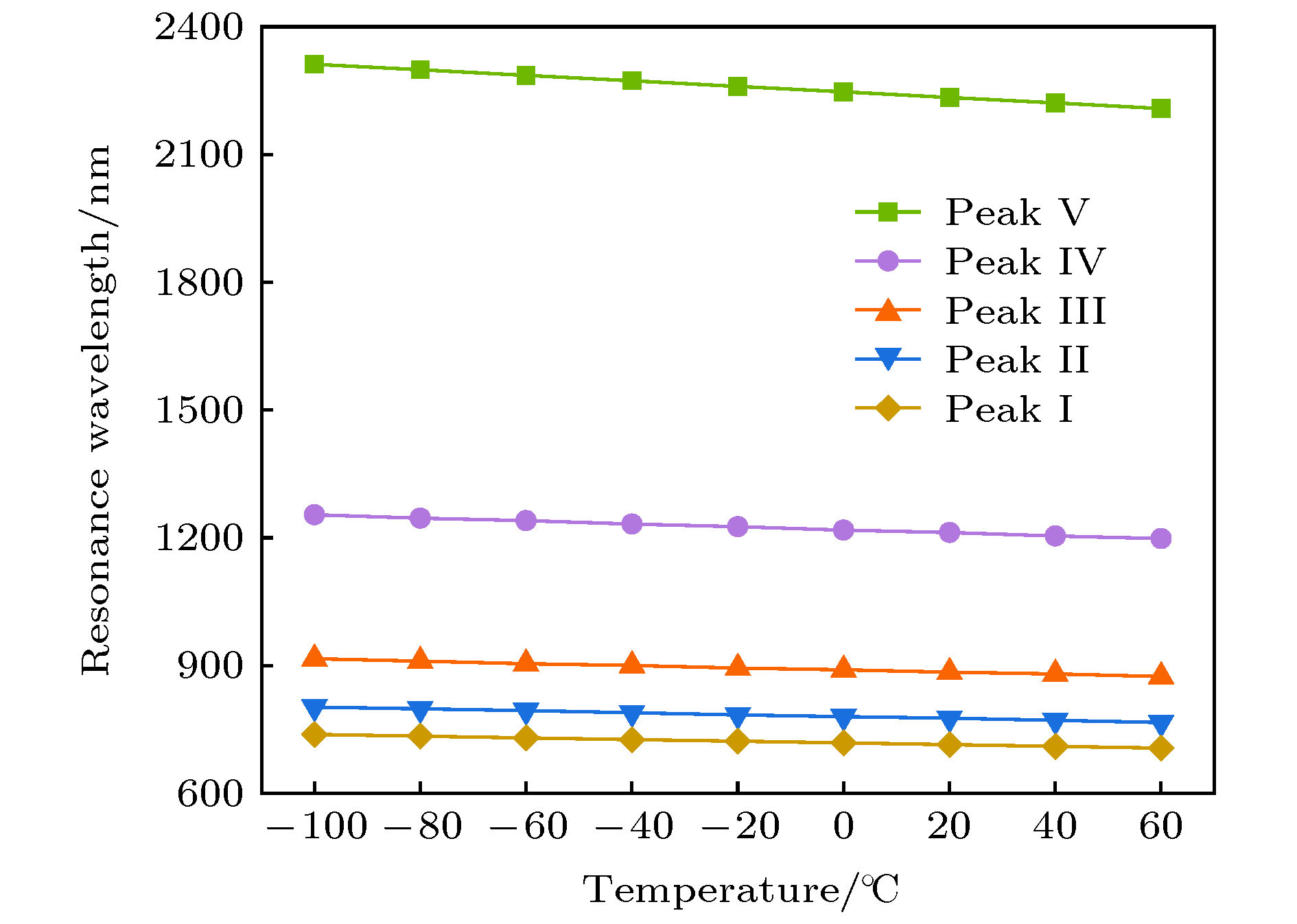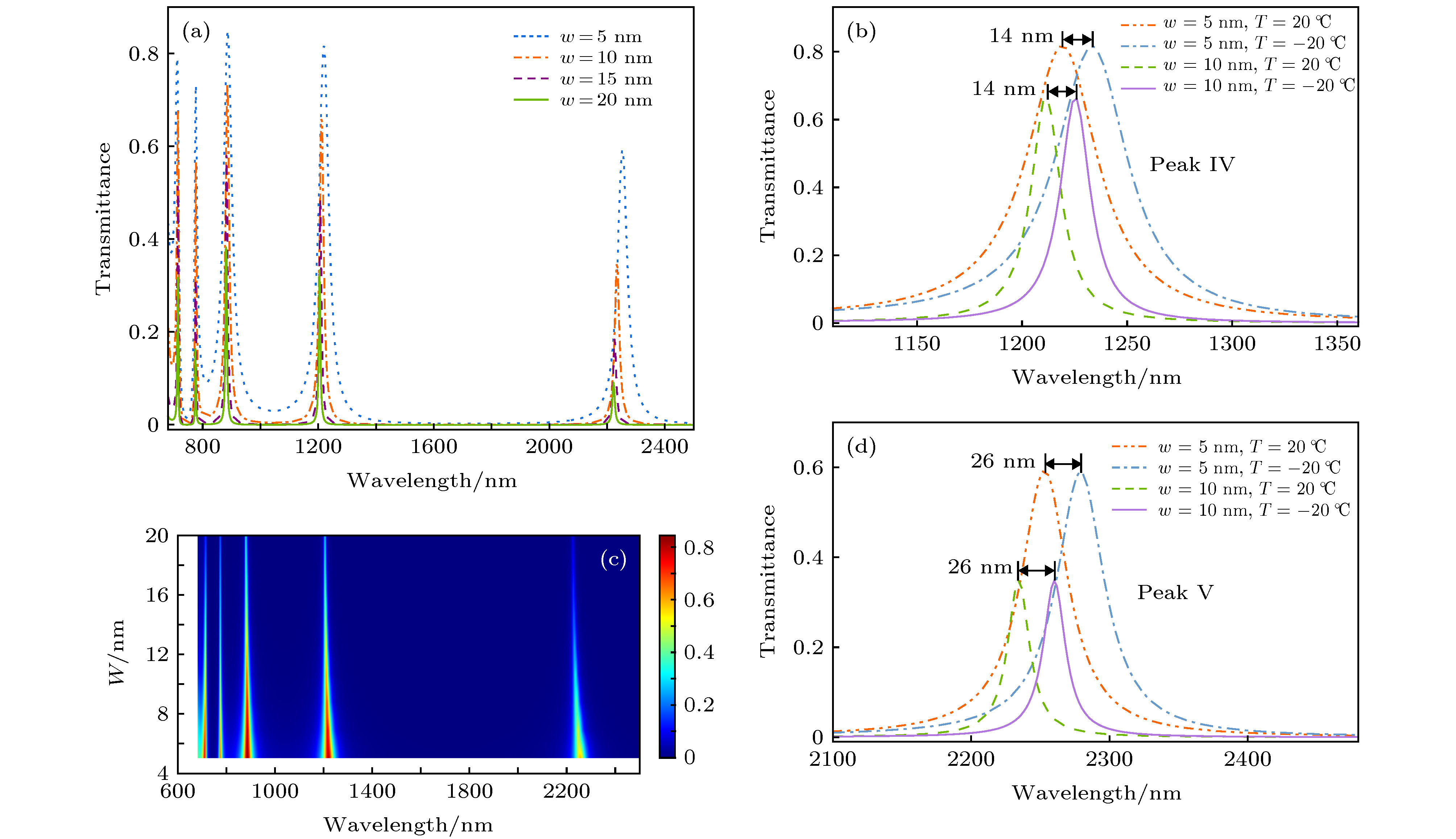-
为了提高现有的亚波长量级温度传感器和折射率传感器的各项工作性能, 本文基于表面等离激元提出了一种拥有尖锐峰的高灵敏度、高集成度的环八边形表面等离子体共振传感器. 理论分析了以乙醇作为热敏填充材料使温度和有效折射率建立线性转换关系的可行性, 并利用多模耦合模式理论(MICMT)对该传感器的透射峰进行了拟合和理论分析, 再利用有限元法(FEM)进行了仿真分析, 理论结果和仿真结果高度匹配. 然后对环八边形共振腔的各项参数进行了有限元数值模拟, 计算得出该传感器的最佳参数设置. 和以往结构设计对比, 该两用传感器拥有工作波段范围广、半峰全宽窄、易于集成等诸多优点, 作为传感器的温度灵敏度和折射率灵敏度分别高达0.9 nm/℃和2400 nm/RIU. 该结构兼具一些传统腔体的优点, 为以后基于表面等离激元设计的微纳光子温度传感和折射率传感两用器件提供了一种高性能的腔体选择.In order to enhance the working performance of existing temperature sensor and refractive index sensor of sub-wavelength waveguide, the design of ring regular octagon surface plasmon resonance sensor with sharp transmission peak, high sensitivity and high integration was proposed in this paper based on surface plasmon polaritons. The feasibility of using ethanol as a thermosensitive filler to establish a linear conversion relationship between temperature and effective refractive index was analyzed theoretically. The reason why the real part of effective refractive index changes abruptly with the change of waveguide width is also explained. The multimode interference coupled mode theory (MICMT) was used to fit and analyze the transmission peak of the sensor, and then the finite element methods (FEM) is used for simulation analysis. Results obtained by the theory of the MICMT are consistent very well with those from simulation. In order to obtain the optimal parameter setting of the ring regular octagon surface plasmon resonance sensor, various parameters of the sensor are simulated by FEM. It is found that increasing L and decreasing H will improve the sensitivity of the sensor, while decreasing parameter w can not only improve the amplitude of transmission peak, but also keep the sensitivity unchanged. This characteristic of parameter w greatly improves the robustness of the sensor. All kinds of physical phenomena in this paper are analyzed in detail. Firstly, the phenomenon of transmission peak displacement caused by parameter changes is explained through the analysis of magnetic field distribution, and then the phenomenon of inconsistent sensitivity of different transmission peaks is explained through photon energy formula. Compared with the previous structural design, the dual-purpose sensor has many advantages such as wide operating wavelength range, narrow full width at half maximum and easy to integrate. As a temperature sensor and refractive index sensor, its sensitivity was as high as 0.9 nm/℃ and 2400 nm/RIU. The study of this structure broke through the limitations of some traditional cavities, in order to provide a high- performance cavity selection for the micro-nano photon temperature and refractive index dual-purpose sensor based on the design of surface plasmon polaritons in the future.
-
Keywords:
- surface plasmon polaritons /
- temperature sensor /
- refractive index sensor /
- multimode interference coupled mode theory
[1] Barnes W L, Dereux A, Ebbesen T W 2003 Nature 424 824
 Google Scholar
Google Scholar
[2] Amini A, Aghili S, Golmohammadi S, Gasemi P 2017 Opt. Commun. 403 226
 Google Scholar
Google Scholar
[3] Hua L, Wang G X, Liu X M 2013 Chin. Sci. Bull. 58 3607
 Google Scholar
Google Scholar
[4] Hwang Y, Kim J E, Park H Y 2011 Opt. Commun. 284 4778
 Google Scholar
Google Scholar
[5] 张志东, 赵亚男, 卢东, 熊祖洪, 张中月 2012 物理学报 61 187301
 Google Scholar
Google Scholar
Zhang Z D, Zhao Y N, Lu D, Xiong Z H, Zhang Z Y 2012 Acta Phys. Sin. 61 187301
 Google Scholar
Google Scholar
[6] 陈颖, 谢进朝, 周鑫德, 张灿, 杨惠, 李少华 2019 物理学报 68 237301
 Google Scholar
Google Scholar
Chen Y, Xie J Z, Zhou X D, Zhang C, Yang H, Li S H 2019 Acta Phys. Sin. 68 237301
 Google Scholar
Google Scholar
[7] Zhang X W, Qi Y P, Zhou P Y, Hu B B, Yan C M 2018 Photonic Sens. 8 367
 Google Scholar
Google Scholar
[8] Chen J, Wang X X, Tang F, Ye X, Yang L M, Zhang Y B 2020 Results Phys. 16 102867
 Google Scholar
Google Scholar
[9] Wang X X, Zhu J K, Wen X L, Wu X X, Wu Y, Su Y W, Tong H, Qi Y P, Yang H 2019 Opt. Mater. Express 9 3079
 Google Scholar
Google Scholar
[10] Singh M, Datta A 2018 IEEE Photonics Technol. Lett. 30 997
 Google Scholar
Google Scholar
[11] Shibayama J, Kawai H, Yamauchi J, Nakano H 2019 Opt. Commun. 452 360
 Google Scholar
Google Scholar
[12] Wang X X, Zhu J K, Wu Y, Xu Y Q, Su Y W, Zhang L P 2020 Results Phys. 17 103175
 Google Scholar
Google Scholar
[13] Li J K, Chen X F, Yi Z, Yang H, Tang Y J, Yi Y, Yao W T, Wang J Q, Yi Y G 2020 Mater. Today Energy 16 100390
 Google Scholar
Google Scholar
[14] Wang Y Y, Chen Z Q, Xu D Y, Yi Z, Chen X F, Chen J, Tang Y J, Wu P H, Li G F, Yi Y G 2020 Results Phys. 16 102951
 Google Scholar
Google Scholar
[15] Qi Y P, Zhang Y, Liu C Q, Zhang T, Zhang B H, Wang L Y, Deng X Y, Bai Y L, Wang X X 2020 Results Phys. 16 103012
 Google Scholar
Google Scholar
[16] Chen J, Nie H, Peng C, Qi S B, Tang C J, Zhang Y, Wang L H, Park G S 2018 J. Lightwave Technol. 36 3481
 Google Scholar
Google Scholar
[17] Pang Z Y, Tong H, Wu X X, Zhu J K, Wang X X, Yang H, Qi Y P 2018 Opt. Quantum Electron. 50 335
 Google Scholar
Google Scholar
[18] Chen J, Nie H, Zha T Q, Mao P, Tang C J, Shen X Y, Park G S 2018 J. Lightwave Technol. 36 2791
 Google Scholar
Google Scholar
[19] Li S L, Wang Y L, Jiao R Z, Wang L L, Yu L 2017 Opt. Express 25 3525
 Google Scholar
Google Scholar
[20] Wu T, Liu Y M, Yu Z Y, Peng Y W, Shu C G, Ye H 2014 Opt. Express 22 7669
 Google Scholar
Google Scholar
[21] Liu Q, Liu M W, Zhan S P, Wu L X, Xie S X, Chen Z H, Zhang Y C 2019 Plasmonics 14 1005
 Google Scholar
Google Scholar
[22] Cen C L, Lin H, Huang J, Liang C P, Chen X F, Tang Y J, Yi Z, Ye X, Liu J W, Yi Y G, Xiao S Y 2018 Sensors 18 4489
 Google Scholar
Google Scholar
[23] Li Z F, Wen K H, Chen L, Lei L, Zhou J Y, Zhou D Y, Fang Y H, Wu B Y 2019 Appl. Opt. 58 4878
 Google Scholar
Google Scholar
[24] Wu T S, Liu Y M, Yu Z Y, Ye H, Peng Y W, Shu C G, Yang C H, Zhang W, He H F 2015 Opt. Commun. 339 1
 Google Scholar
Google Scholar
[25] Qi Y P, Zhou P Y, Zhang T, Zhang X W, Wang Y, Liu C Q, Bai Y L, Wang X X 2019 Results Phys. 14 102506
 Google Scholar
Google Scholar
[26] 伍铁生, 王丽, 王哲, 刘玉敏, 胡署阳, 尹丽丹 2012 中国激光 39 1114002
 Google Scholar
Google Scholar
Wu T S, Wang L, Wang Z, Liu Y M, Yin L D 2012 Chin. J. Lasers 39 1114002
 Google Scholar
Google Scholar
[27] Sundari S T, Srinivasu K, Dash S, Tyagi A K 2013 Solid State Commun. 167 36
 Google Scholar
Google Scholar
[28] Lin X S, Huang X G 2009 Opt. Lett. 33 2874
[29] 祁云平, 张雪伟, 周培阳, 胡兵兵, 王向贤 2018 物理学报 67 197301
 Google Scholar
Google Scholar
Qi Y P, Zhang X W, Zhou P Y, Hu B B, Wang X X 2018 Acta Phys. Sin. 67 197301
 Google Scholar
Google Scholar
[30] Dionne J A, Sweatlock L A, Atwater H A 2006 Phys. Rev. B 73 035407
 Google Scholar
Google Scholar
[31] Wu T S, Liu Y M, Yu Z Y, Peng Y W, Shu C G, He H F 2014 Opt. Commun. 323 44
 Google Scholar
Google Scholar
[32] Cheng Q Q, Li T, Li L, Wang S M, Zhu S N 2014 Opt. Lett. 39 3900
 Google Scholar
Google Scholar
[33] Ren M X, Pan C P, Li Q Q, Cai W 2013 Opt. Lett. 38 3133
 Google Scholar
Google Scholar
-
图 3 (a) 该温度传感器的透射率仿真值和理论值对比图; (b) Peak I的磁场分布图,
${\lambda _{10}} = 714\;{\rm{nm}}$ ; (c) Peak II的磁场分布图,${\lambda _{20}} = 776\;{\rm{nm}}$ ; (d) Peak III的磁场分布图,${\lambda _{30}} = 884\;{\rm{nm}}$ ; (e) Peak IV的磁场分布图,${\lambda _{40}} = 1212\;{\rm{nm}}$ ; (f) Peak V的磁场分布图,${\lambda _{50}} = $ 2234 nmFig. 3. (a) Comparison of the simulation and the theoretical results of transmittance of the temperature sensor; (b) the magnetic field
$\left| {{H_z}} \right|$ of peak I at${\lambda _{10}} = 714\;{\rm{nm}}$ ; (c) the magnetic field$\left| {{H_z}} \right|$ of peak II at${\lambda _{20}} = 776\;{\rm{nm}}$ ; (d) the magnetic field$\left| {{H_z}} \right|$ of peak III at${\lambda _{30}} = 884\;{\rm{nm}}$ ; (e) the magnetic field$\left| {{H_z}} \right|$ of peak IV at${\lambda _{40}} = 1212\;{\rm{nm}}$ ; (f) the magnetic field$\left| {{H_z}} \right|$ of peak V at${\lambda _{50}} = 2234\;{\rm{nm}}$ .图 4 温度变化时该温度传感器的透射光谱图 (a) 入射波长范围为690—1100 nm, Peak I, Peak II, Peak III在该光谱范围内; (b) 入射波长范围为1000—2500 nm, Peak IV, Peak V在该光谱范围内
Fig. 4. The transmission spectra of the temperature sensor under different T: (a) Peak I, Peak II and Peak III in the wavelength range of 690 nm to 1100 nm; (b) peak IV and Peak V in the wavelength range of 1000 nm to 2500 nm.
图 6 改变参数H的透射谱图 (a) 在740—1025 nm的入射波长下; (b) 在1000—2500 nm的入射波长下. (c) 在1000—3000 nm的入射波长下, 改变参数L的透射谱图; (d) Peak V和Peak IV的灵敏度和参数H的关系图; (e) Peak V和Peak IV的灵敏度和参数L的关系图
Fig. 6. The transmission spectra of the structure under different H: (a) In the wavelength range of 690 nm to 1100 nm; (b) in the wavelength range of 1000 nm to 2500 nm. (c) the transmission spectra of the structure under different L in the wavelength range of 1000 nm to 3000 nm; (d) the relationship between sensitivity of Peak V and Peak IV and parameter H; (e) the relationship between sensitivity of Peak V and Peak IV and parameter L.
图 7 (a) 在不同的w取值下的透射谱图; (b) Peak IV在w = 5 nm和w = 10 nm时温度从20 ℃变到–20 ℃时共振峰位移量对比图; (c) 在w不同取值情况下随入射波长变化的透射光谱图; (d) Peak V在w = 5 nm和w = 10 nm时温度从20 ℃变到–20 ℃时共振峰位移量对比图
Fig. 7. (a) The transmission spectra of the structure under different w; (b) when the temperature changes from 20 ℃ to –20 ℃, the displacement of Peak IV at w = 5 nm and w = 10 nm; (c) the transmission spectra of the structure with different wavelength and w; (d) when the temperature changes from 20 ℃ to –20 ℃, the displacement of Peak V at w = 5 nm and w = 10 nm.
图 8 (a) 该系统作为温度传感器时, 在T = 20 ℃和T = –20 ℃下的透射谱图; (b) 该系统作为折射率传感器时, 在n = 1和n = 1.01下的透射谱图
Fig. 8. (a) When the system is used as a temperature sensor, the transmission spectra at T = 20 ℃ and T = –20 ℃; (b) when the system is used as a refractive index sensor, the transmission spectra at n = 1 and n = 1.01.
表 1 各类温度传感器和折射率传感器性能比较
Table 1. Performance comparison of various temperature sensors and refractive index sensors.
-
[1] Barnes W L, Dereux A, Ebbesen T W 2003 Nature 424 824
 Google Scholar
Google Scholar
[2] Amini A, Aghili S, Golmohammadi S, Gasemi P 2017 Opt. Commun. 403 226
 Google Scholar
Google Scholar
[3] Hua L, Wang G X, Liu X M 2013 Chin. Sci. Bull. 58 3607
 Google Scholar
Google Scholar
[4] Hwang Y, Kim J E, Park H Y 2011 Opt. Commun. 284 4778
 Google Scholar
Google Scholar
[5] 张志东, 赵亚男, 卢东, 熊祖洪, 张中月 2012 物理学报 61 187301
 Google Scholar
Google Scholar
Zhang Z D, Zhao Y N, Lu D, Xiong Z H, Zhang Z Y 2012 Acta Phys. Sin. 61 187301
 Google Scholar
Google Scholar
[6] 陈颖, 谢进朝, 周鑫德, 张灿, 杨惠, 李少华 2019 物理学报 68 237301
 Google Scholar
Google Scholar
Chen Y, Xie J Z, Zhou X D, Zhang C, Yang H, Li S H 2019 Acta Phys. Sin. 68 237301
 Google Scholar
Google Scholar
[7] Zhang X W, Qi Y P, Zhou P Y, Hu B B, Yan C M 2018 Photonic Sens. 8 367
 Google Scholar
Google Scholar
[8] Chen J, Wang X X, Tang F, Ye X, Yang L M, Zhang Y B 2020 Results Phys. 16 102867
 Google Scholar
Google Scholar
[9] Wang X X, Zhu J K, Wen X L, Wu X X, Wu Y, Su Y W, Tong H, Qi Y P, Yang H 2019 Opt. Mater. Express 9 3079
 Google Scholar
Google Scholar
[10] Singh M, Datta A 2018 IEEE Photonics Technol. Lett. 30 997
 Google Scholar
Google Scholar
[11] Shibayama J, Kawai H, Yamauchi J, Nakano H 2019 Opt. Commun. 452 360
 Google Scholar
Google Scholar
[12] Wang X X, Zhu J K, Wu Y, Xu Y Q, Su Y W, Zhang L P 2020 Results Phys. 17 103175
 Google Scholar
Google Scholar
[13] Li J K, Chen X F, Yi Z, Yang H, Tang Y J, Yi Y, Yao W T, Wang J Q, Yi Y G 2020 Mater. Today Energy 16 100390
 Google Scholar
Google Scholar
[14] Wang Y Y, Chen Z Q, Xu D Y, Yi Z, Chen X F, Chen J, Tang Y J, Wu P H, Li G F, Yi Y G 2020 Results Phys. 16 102951
 Google Scholar
Google Scholar
[15] Qi Y P, Zhang Y, Liu C Q, Zhang T, Zhang B H, Wang L Y, Deng X Y, Bai Y L, Wang X X 2020 Results Phys. 16 103012
 Google Scholar
Google Scholar
[16] Chen J, Nie H, Peng C, Qi S B, Tang C J, Zhang Y, Wang L H, Park G S 2018 J. Lightwave Technol. 36 3481
 Google Scholar
Google Scholar
[17] Pang Z Y, Tong H, Wu X X, Zhu J K, Wang X X, Yang H, Qi Y P 2018 Opt. Quantum Electron. 50 335
 Google Scholar
Google Scholar
[18] Chen J, Nie H, Zha T Q, Mao P, Tang C J, Shen X Y, Park G S 2018 J. Lightwave Technol. 36 2791
 Google Scholar
Google Scholar
[19] Li S L, Wang Y L, Jiao R Z, Wang L L, Yu L 2017 Opt. Express 25 3525
 Google Scholar
Google Scholar
[20] Wu T, Liu Y M, Yu Z Y, Peng Y W, Shu C G, Ye H 2014 Opt. Express 22 7669
 Google Scholar
Google Scholar
[21] Liu Q, Liu M W, Zhan S P, Wu L X, Xie S X, Chen Z H, Zhang Y C 2019 Plasmonics 14 1005
 Google Scholar
Google Scholar
[22] Cen C L, Lin H, Huang J, Liang C P, Chen X F, Tang Y J, Yi Z, Ye X, Liu J W, Yi Y G, Xiao S Y 2018 Sensors 18 4489
 Google Scholar
Google Scholar
[23] Li Z F, Wen K H, Chen L, Lei L, Zhou J Y, Zhou D Y, Fang Y H, Wu B Y 2019 Appl. Opt. 58 4878
 Google Scholar
Google Scholar
[24] Wu T S, Liu Y M, Yu Z Y, Ye H, Peng Y W, Shu C G, Yang C H, Zhang W, He H F 2015 Opt. Commun. 339 1
 Google Scholar
Google Scholar
[25] Qi Y P, Zhou P Y, Zhang T, Zhang X W, Wang Y, Liu C Q, Bai Y L, Wang X X 2019 Results Phys. 14 102506
 Google Scholar
Google Scholar
[26] 伍铁生, 王丽, 王哲, 刘玉敏, 胡署阳, 尹丽丹 2012 中国激光 39 1114002
 Google Scholar
Google Scholar
Wu T S, Wang L, Wang Z, Liu Y M, Yin L D 2012 Chin. J. Lasers 39 1114002
 Google Scholar
Google Scholar
[27] Sundari S T, Srinivasu K, Dash S, Tyagi A K 2013 Solid State Commun. 167 36
 Google Scholar
Google Scholar
[28] Lin X S, Huang X G 2009 Opt. Lett. 33 2874
[29] 祁云平, 张雪伟, 周培阳, 胡兵兵, 王向贤 2018 物理学报 67 197301
 Google Scholar
Google Scholar
Qi Y P, Zhang X W, Zhou P Y, Hu B B, Wang X X 2018 Acta Phys. Sin. 67 197301
 Google Scholar
Google Scholar
[30] Dionne J A, Sweatlock L A, Atwater H A 2006 Phys. Rev. B 73 035407
 Google Scholar
Google Scholar
[31] Wu T S, Liu Y M, Yu Z Y, Peng Y W, Shu C G, He H F 2014 Opt. Commun. 323 44
 Google Scholar
Google Scholar
[32] Cheng Q Q, Li T, Li L, Wang S M, Zhu S N 2014 Opt. Lett. 39 3900
 Google Scholar
Google Scholar
[33] Ren M X, Pan C P, Li Q Q, Cai W 2013 Opt. Lett. 38 3133
 Google Scholar
Google Scholar
计量
- 文章访问数: 9582
- PDF下载量: 89
- 被引次数: 0














 下载:
下载:
























